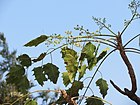Note: This is a project under development. The articles on this wiki are just being initiated and broadly incomplete. You can Help creating new pages.
Difference between revisions of "Ailanthus excelsa - Aralu, Indian tree of heaven"
(→External Links) |
(→Commonly seen growing in areas) |
||
| Line 43: | Line 43: | ||
==Commonly seen growing in areas== | ==Commonly seen growing in areas== | ||
| − | {{Commonly seen|Field border | + | {{Commonly seen|Field border}}, {{Commonly seen|Wet area}}. |
==Photo Gallery== | ==Photo Gallery== | ||
Revision as of 17:28, 1 May 2018
Ailanthus excelsa, commonly known as tree of heaven, is a large deciduous tree found in India and Sri Lanka. In Tamil, it is also known as Pi-Nari Maram due to its disagreeable odour.There are many related species in Ailanthus.
Contents
Uses
Parts Used
Chemical Composition
Malanthine, B-Sitosterol[1]
Common names
| Language | Common name |
|---|---|
| Kannada | Bende, dodabevu, dodda |
| Hindi | Mahanimb, Maharukh |
| Malayalam | Mattipongilyam, Peru, Perumaram |
| Tamil | Perumaram, perumaruntu |
| Telugu | pedda, peddamandu, peddamanu |
| Marathi | NA |
| Gujarathi | NA |
| Punjabi | NA |
| Kashmiri | NA |
| Sanskrit | aralu, araluka, araluvrksa |
| English | Indian Tree of Heaven, Coramandel ailanto |
Habit
Identification
Leaf
| Kind | Shape | Feature |
|---|---|---|
| Hunse like | Oblong-lanceolate | Oblong-lanceolate is Subopposite, Leaf Apex is Acuminate, Leaf Base is Oblique and Leaf Margin is Irregularly toothed-sublobate |
.[2]
Flower
| Type | Size | Color and composition | Stamen | More information |
|---|---|---|---|---|
| Terminal panicles | greenish-yellow | 8-10 | Flowering from January-March |
Fruit
| Type | Size | Mass | Appearance | Seeds | More information |
|---|---|---|---|---|---|
| oblong samara | 7–10 mm (0.28–0.4 in.) long pome | prominently nerved, membranous | seed 1 | {{{6}}} |
Other features
List of Ayurvedic medicine in which the herb is used
- Vishatinduka Taila as root juice extract
Where to get the saplings
Mode of Propagation
How to plant/cultivate
A plant of the semi-arid to wet tropics, where it is found at elevations up to 900 metres. It grows best in areas where annual daytime temperatures are within the range 20 - 40°c, but can tolerate 4 - 47°c[3]
Commonly seen growing in areas
Photo Gallery
References
External Links
Categories:
- Pages that are stubs
- Ayurvedic Herbs known to be helpful to treat migraines
- Herbs with Leaves used in medicine
- Herbs with Bark used in medicine
- Herbs with Root used in medicine
- Herbs with common name in Kannada
- Herbs with common name in Hindi
- Herbs with common name in Malayalam
- Herbs with common name in Tamil
- Herbs with common name in Telugu
- Herbs with common name in Sanskrit
- Herbs with common name in English
- Habit - Deciduous Tree
- Index of Plants which can be propagated by Seeds
- Herbs that are commonly seen in the region of Field border
- Herbs that are commonly seen in the region of Wet area
- Herbs




